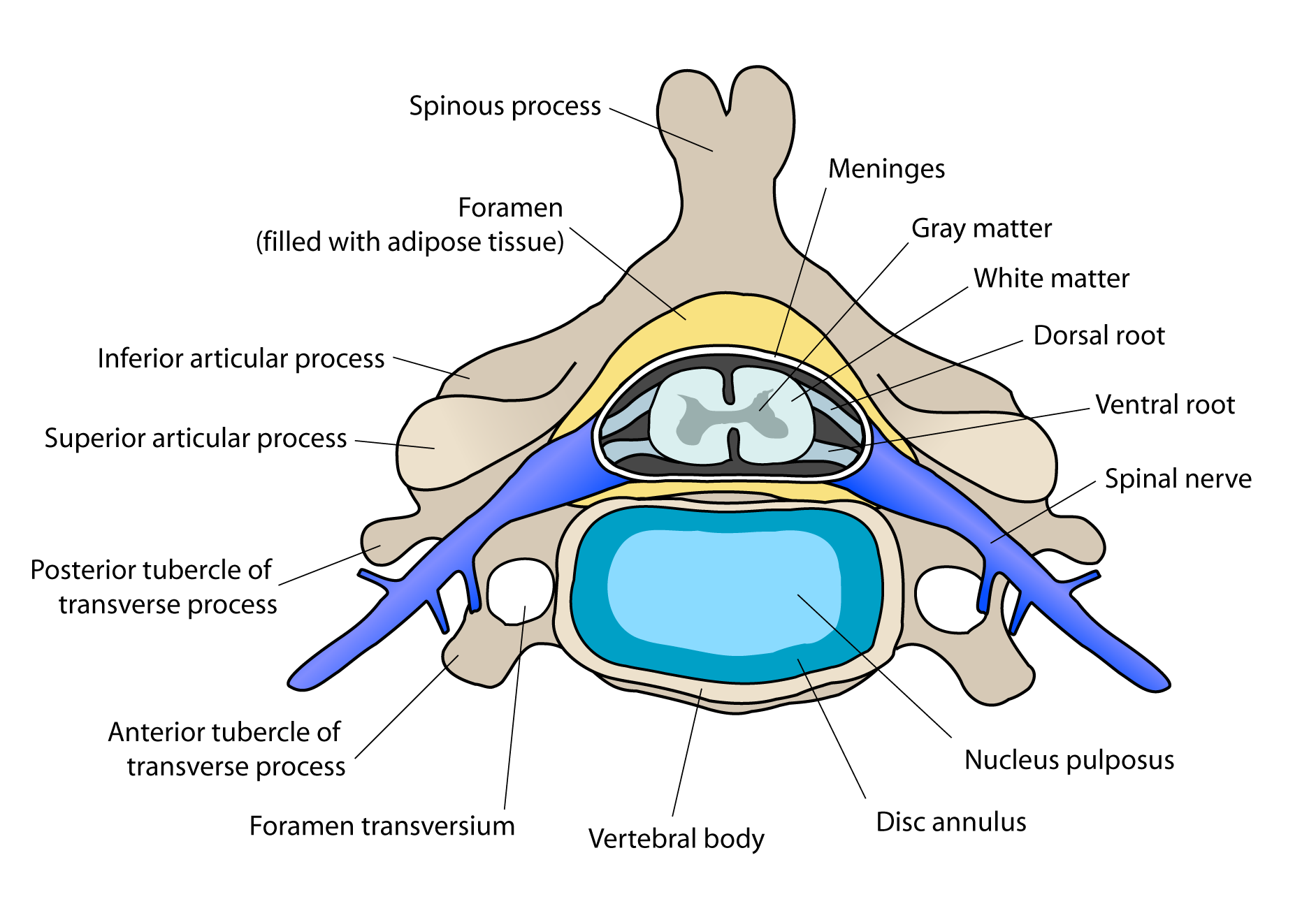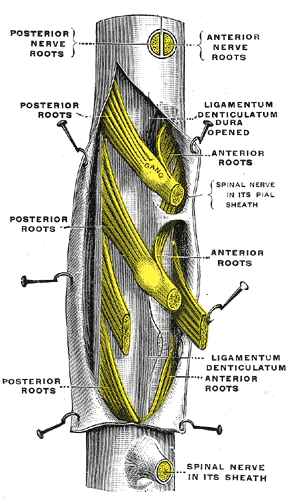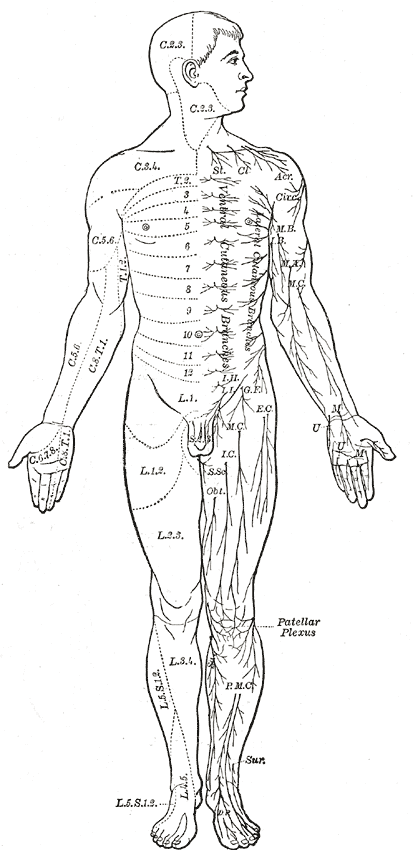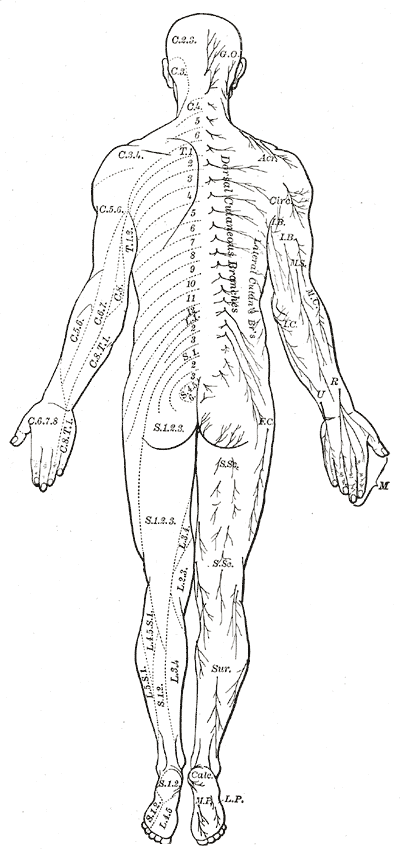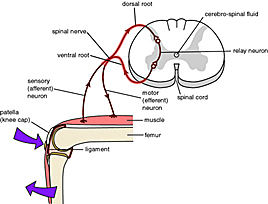Spinal nerve
Editor-In-Chief: C. Michael Gibson, M.S., M.D. [1]
Template:Infobox Nerve The term spinal nerve generally refers to the mixed spinal nerve, which is formed from the dorsal and ventral roots that come out of the spinal cord. The spinal nerve is the bit that passes out of the vertebrae through the intervertebral foramen. All spinal nerves are part of the peripheral nervous system (PNS).
Numbering
There are a total of 31 bilaterally-paired spinal nerves :
- 8 cervical nerves (C1-C8)
- 12 thoracic nerves (T1-T12)
- 5 lumbar nerves (L1-L5)
- 5 sacral nerves (S1-S5)
- 1 coccygeal nerve (Co)
The first to seventh cervical nerves (C1 to C7) exit from the vertebral canal above the respective cervical vertebra (that is to say, C1 exits above the first cervical vertebra; C2 exits above the second, and so forth). The C8 spinal nerve exits below the seventh cervical vertebra, and all the other spinal nerves leave below their corresponding vertebra.
Formation of the spinal nerves
Inside the spinal cord, there is grey matter, surrounded by white matter. From out of the grey matter, two dorsal roots (one on the left side, and one on the right side) and two ventral roots emerge. (Dorsal means back, ventral means front.) As the body is symmetrical, the same thing happens on both the left and right side of the body. This happens in each vertebra of the spine.
- The dorsal roots contain afferent sensory axons, and the ventral roots contain efferent motor axons. The dorsal roots of each side continue outwards, along the way forming a dorsal root ganglion (also called a spinal ganglion).
- The ventral roots similarly continue out from the spinal column, and meet and mix with their corresponding dorsal nerve root at a point after the ganglion.
At this point, the combination of the dorsal roots and ventral roots is called a mixed spinal nerve.
Fate of the spinal nerve
After the dorsal and ventral roots fuse to form a spinal nerve, the nerve bifurcates into dorsal and ventral primary rami. Each primary ramus has two branches.
Dorsal
- The dorsal primary ramus supplies the muscles and sensory nerves of the back.
The two main branches are a lateral and medial branch.
Ventral
- The ventral primary ramus supplies the rest of the body wall.
The two main branches are an anterior and lateral cutaneous branch. In addition, the anterior cutaneous bifurcates, forming a medial and lateral branch, while the lateral cutaneous branch splits into an anterior and posterior branch. These secondary and tertiary branches themselves typically have muscular and sensory branches that innervate the body wall.
The ventral primary rami also give rise to the roots of the various nervous plexuses (e.g. the brachial plexus), which become the sensory and motor nerves of the limbs.
Before forming the plexuses, the ventral rami have two branches leading to a sympathetic ganglion. These ganglia connect to the one above and below them, forming the sympathetic chain.
Importance of the spinal nerves
The muscles that one particular spinal root supplies are that nerve's myotome, and the dermatomes are the areas of sensory innervation on the skin for each spinal nerve.
This is of great importance in the diagnosis of neurological disorders, as lesions of one or more nerve roots result in typical patterns of neurologic defects (muscle weakness, loss of sensation) that allow localisation of the causating lesion.
Additional images
-
Cervical vertebra
-
A portion of the spinal cord, showing its right lateral surface. The dura is opened and arranged to show the nerve roots.
-
Distribution of cutaneous nerves. Ventral aspect.
-
Distribution of cutaneous nerves. Dorsal aspect.
-
The mechanism of the reflex arc
External links
Template:Spinal nerves Template:Spinal cord Template:Vertebral column and spinal cord
de:Spinalnerv hr:Moždinski živci it:Nervo spinale no:Spinalnerve fi:Selkäydinhermo sv:Ryggmärgsnerv te:కశేరు నాడులు
